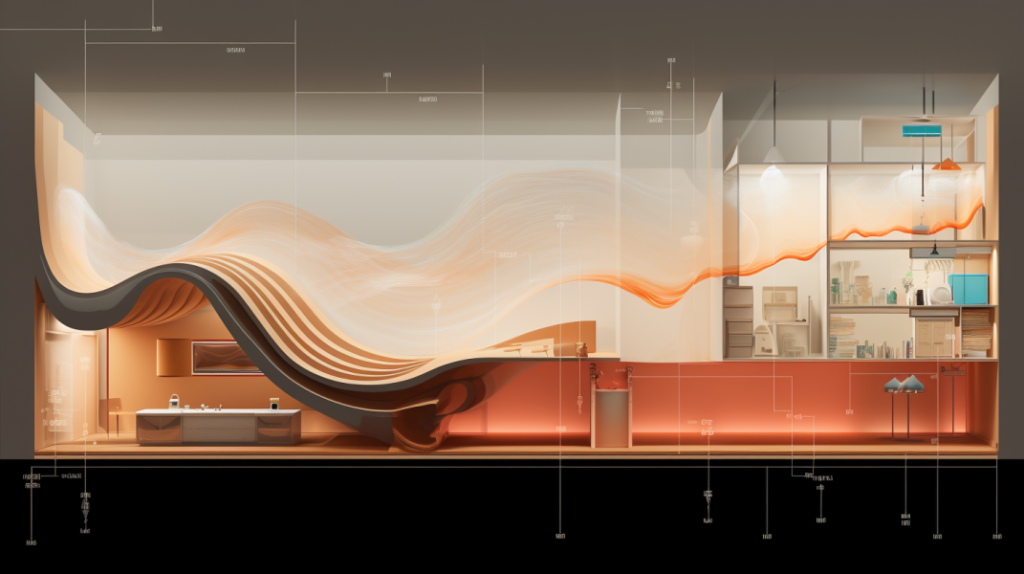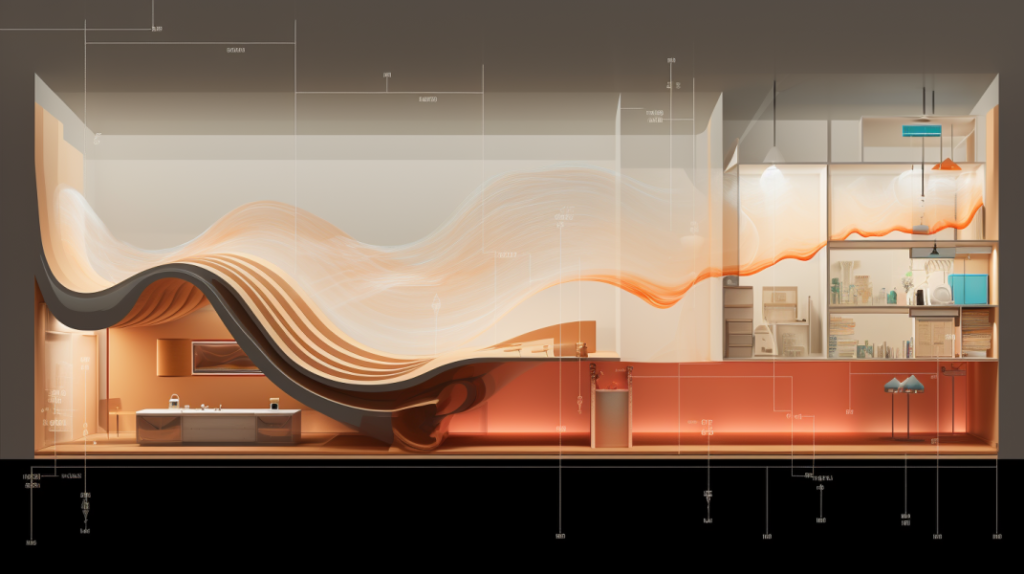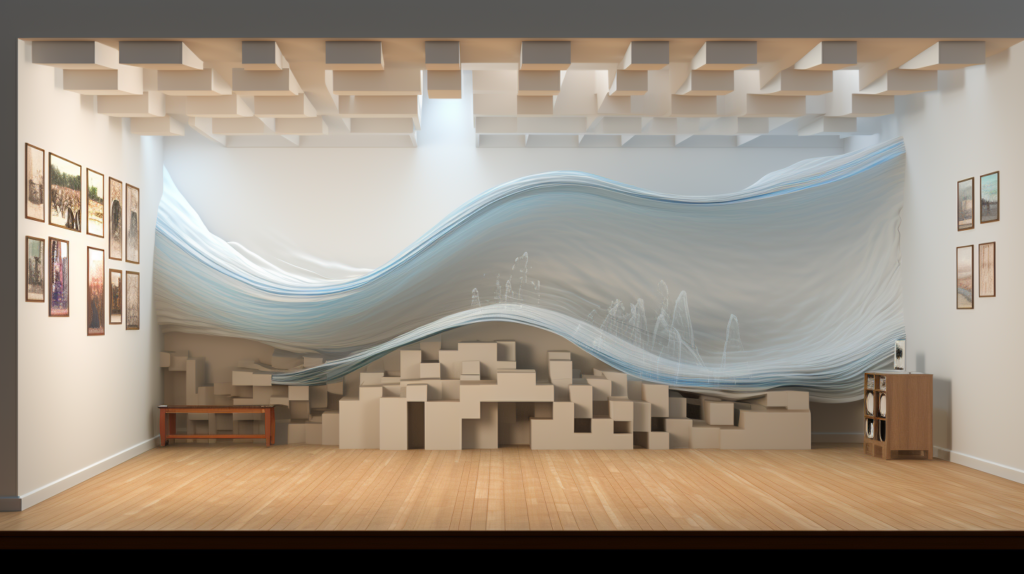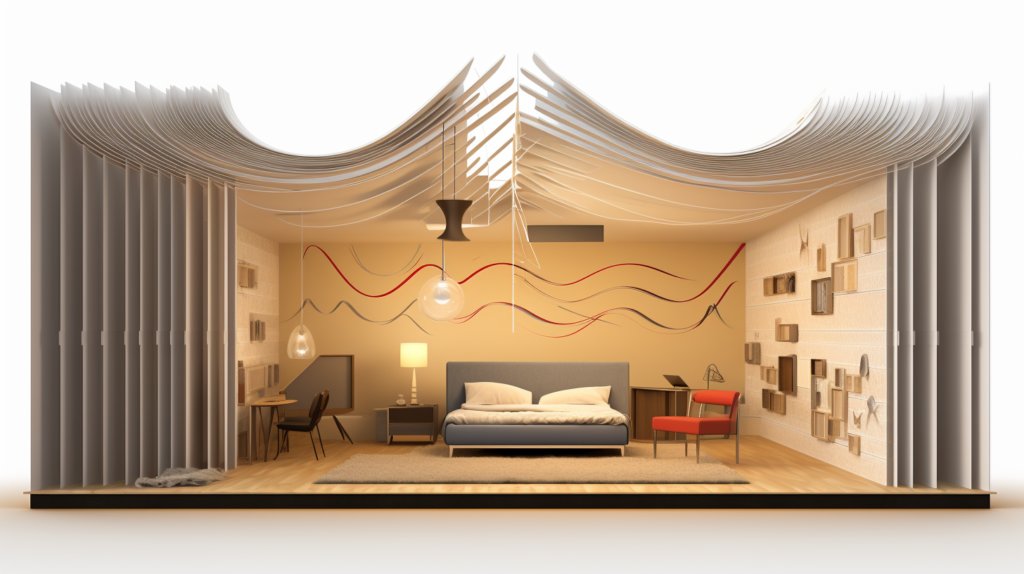The mere mention of soundproofing often conjures up images of hefty bills, specialized contractors, and complex renovations. But what if there was a way to achieve tranquility without emptying your pockets?
Soundproofing is not just about silencing the world outside; it’s about mastering the art and science of acoustics using both conventional and unconventional methods.
And while many believe that effective soundproofing is reserved for those with deep pockets, there are budget-friendly strategies that can bring about meaningful noise reduction.
If the idea of affordable soundproofing sounds intriguing, let’s dive deeper into the nuances of wall soundproofing, unraveling its intricacies, challenges, and cost-effective solutions that can reshape your auditory environment.
Understanding Wall Soundproofing

At the core of soundproofing is a fundamental understanding of how sound behaves. Sound, to put it simply, is a series of pressure waves generated by vibrating objects.
These waves propagate through various mediums – air, water, or solid materials. When these waves encounter a barrier like a wall, they induce vibrations in that barrier.
This phenomenon is what allows us to hear a loud music system from another room or the honk of vehicles from the street even when indoors.
Walls, depending on their construction and the materials used, have a varying degree of resistance to these vibrations.
For instance, a thick concrete wall will impede sound much more effectively than a thin wooden partition.
The spaces within the wall, the type of insulation used, and even the paint or wallpaper can influence how sound is transmitted or reflected.
Differentiating Sound Absorption and Sound Blocking
Soundproofing can be approached from two primary angles: absorption and blocking.
Absorption is about capturing the sound waves and converting their energy, thus preventing them from reflecting back into the room.
Materials like acoustic foam panels excel at this, as they have open-celled structures that trap sound waves, transforming their energy into a minuscule amount of heat.
Sound blocking, on the other hand, is a more direct approach. It’s about creating a barrier that sound waves find hard to penetrate.
This is where the principles of mass and density come into play. Heavy, dense materials obstruct the path of sound waves, reducing the amount that gets through.
It’s the reason why you might find it hard to hear conversations outside a thick-walled bank vault.
The Two-Fold Approach: Mass and Decoupling
In the world of soundproofing, two principles reign supreme: adding mass and decoupling. Adding mass is a straightforward concept.
The denser and heavier a wall is, the more resistant it is to sound wave vibrations. It’s the reason why sounds from the outside world become muted when you shut the thick door of a luxury car.
Decoupling is a tad more complex but equally crucial. It involves creating a break or a gap in the structure of the wall.
This gap acts as a barrier, preventing sound waves from traveling through the wall uninterrupted.
Think of it like a bridge with a section missing; vehicles (or in this case, sound waves) can’t cross over seamlessly.
Common Challenges with Wall Soundproofing

The myriad of sounds that surround us can be classified into two broad categories: airborne and impact. Airborne sounds are those that travel through the air.
It could be the distant hum of a refrigerator, the melodious chirping of birds on a spring morning, or the incessant honking during rush hour traffic.
These sounds, more often than not, seep into our homes and offices, becoming a part of the ambient noise.
Impact noise, also known as structure-borne noise, is a different beast altogether. It originates from the impact of an object on a surface.
The rhythmic thumping of a neighbor’s workout routine, the clatter of heels on a hardwood floor, or the vibration of a washing machine during its spin cycle all fall into this category.
These sounds, being directly linked to vibrations in a structure, can be particularly challenging to address.
Dealing with Thin and Shared Walls
The modern architectural trend, especially in urban settings, leans towards maximizing space. This often translates to thinner walls, which, while great for saving space, are a nemesis for soundproofing.
Thin walls lack the mass and density required to effectively impede sound waves, making them prone to transmitting noises from adjoining rooms or even neighboring apartments.
Shared walls, or party walls, present their own set of challenges. These walls separate two independent living spaces and are often the primary culprits for noise disputes among neighbors.
Whether it’s the blaring sound of a late-night movie marathon, the rhythmic beats of a practicing musician, or the animated discussions of a family dinner, shared walls transmit them all, often leading to strained relations among neighbors.
The Budgetary Constraints and Soundproofing
Professional soundproofing, with its specialized materials and techniques, often comes with a hefty price tag. This puts it out of reach for many, leading to a quest for cheaper, DIY alternatives.
While many budget-friendly methods offer a degree of noise reduction, they seldom match the effectiveness of professional solutions.
Moreover, budget constraints often mean prioritizing certain areas over others, leading to incomplete soundproofing that might not deliver the desired results.
Have Proper Expectations for Cheap Soundproofing

When navigating the world of budget soundproofing, it’s essential to temper expectations.
While cost-effective methods can make a difference, their efficacy often pales in comparison to professional solutions.
For instance, weatherstripping can seal gaps and reduce drafts, thereby diminishing some external noises, but it won’t offer the comprehensive soundproofing that specialized materials and methods might.
Furthermore, many budget-friendly approaches address specific types of noises but might be ineffective against others.
A thick curtain might muffle the sounds of chatter from the street, but it might not do much against the deep rumble of a passing truck.
Therefore, it’s crucial to identify the primary noise sources and select methods that target those specifically.
Why Complete Silence Might Be Unattainable
The allure of a completely silent sanctuary, untouched by the cacophonies of the outside world, is undeniable.
However, achieving this level of quiet is a herculean task, especially in densely populated urban areas.
Even the most robust soundproofing measures can struggle against certain frequencies or volumes of noise.
Moreover, it’s worth noting that true silence can feel unnatural to many.
In environments devoid of all sound, individuals often become hyper-aware of internal noises, such as their breathing or heartbeat.
Some even find such silence unsettling or discomforting. Thus, the goal of soundproofing should be realistic noise reduction rather than absolute silence.
Weighing Cost, Aesthetics, and Effectiveness
Soundproofing decisions often involve a balancing act between cost, aesthetics, and effectiveness.
While a room lined with acoustic foam panels might be highly effective in dampening sound, it might not align with the desired aesthetic of a cozy living room or a professional office space.
Similarly, while a bookshelf laden with books against a wall is an aesthetically pleasing solution, its soundproofing capacity might be limited.
Making informed decisions requires a thorough understanding of the available options, their costs, and their potential impact on the room’s aesthetics and functionality.
It’s a complex matrix of factors, and striking the right balance is crucial for long-term satisfaction.
How to Soundproof Walls Cheaply (and the Trade-offs)
Before delving into more complex soundproofing measures, it’s wise to address the basics. Small gaps, cracks, or openings in walls, floors, or ceilings can be significant culprits in letting in unwanted noise.
Acoustic caulk, with its sound-dampening properties, offers an affordable solution to this problem.
By meticulously sealing all potential entry points for sound, one can achieve a noticeable improvement in a room’s acoustic environment.
The Bookshelf Solution
While the idea of using a bookshelf as a soundproofing tool might seem simplistic, it’s grounded in solid acoustic principles.
A bookshelf, especially one filled with varied books, can serve as a diffuser, scattering sound waves and preventing them from focusing on specific points. Additionally, the mass of the books can act as a barrier, reducing the transmission of certain frequencies of sound.
However, it’s important to recognize the limitations of this approach. While it can offer some relief from medium to high-frequency noises, it might be less effective against low-frequency sounds.
The Debate on Soundproofing Blankets or Curtains
The market today is flooded with products that promise effective soundproofing without significant structural changes.
Soundproofing blankets and curtains are among the most popular of these products.
Made from dense materials, these products aim to reduce the transmission of sound by adding mass to the existing structure.
While they can certainly dampen some noises, their effectiveness is variable and depends on the type of noise, its frequency, and its volume. Additionally, not everyone finds these solutions aesthetically appealing, leading to potential trade-offs between function and form.
Investing Properly in Soundproofing

While budget solutions can offer some respite, there’s a strong argument to be made for investing in proper soundproofing, especially if noise is a significant concern.
Professional soundproofing solutions, though more expensive upfront, offer long-term benefits in terms of peace, comfort, and even property value.
A well-soundproofed home can be a selling point, potentially fetching higher prices in the real estate market.
Considering Soundproofing Earbuds or Earphones
In situations where room or wall soundproofing is impractical or insufficient, personal soundproofing devices can be a godsend.
Modern earbuds and earphones, equipped with noise-canceling technology, can effectively mute a wide range of external sounds.
Whether it’s the drone of an airplane, the chatter of a busy cafe, or the hum of traffic, these devices can create a personal bubble of silence, allowing for focus, relaxation, or undisturbed sleep.
Common Myths and Misconceptions about Wall Soundproofing

In the age of the internet, myths spread as quickly as facts. The idea that egg cartons can be used for effective soundproofing is one such myth.
While egg cartons might alter the acoustics of a room slightly, their soundproofing capabilities are extremely limited.
Their design might scatter some sound waves, reducing echoes, but they offer little in terms of blocking external noises.
DIY Methods and Their Effectiveness
The digital era has ushered in a wave of DIY enthusiasts.
While this spirit of self-reliance and innovation is commendable, it’s essential to approach DIY soundproofing methods with a healthy dose of skepticism.
Not all methods are grounded in sound science, and some can even exacerbate noise issues. Before diving into a DIY project, thorough research and consultation with experts can prevent potential pitfalls.
The Importance of a Comprehensive Approach
It’s not uncommon for individuals to focus their soundproofing efforts on walls while overlooking other potential weak points like doors, windows, or vents.
True soundproofing is a holistic endeavor that requires a multi-faceted approach. By addressing only one aspect, one might still find themselves plagued by noise issues.
A comprehensive soundproofing plan takes into account all potential sources of noise, ensuring a harmonious, quiet environment.
Conclusion
Soundproofing is more than just a home improvement task; it’s a journey into the intricate world of acoustics, materials, and architectural nuances.
As we’ve explored, walls play a pivotal role in the transmission and reflection of sound, acting as gatekeepers between our personal sanctuaries and the bustling external world.
While the quest for complete silence might be a lofty one, with the right knowledge, tools, and techniques, significant noise reduction is with in reach.
From understanding the basic principles of sound behavior to debunking common myths, it’s clear that effective soundproofing is both an art and a science.
Whether you opt for DIY methods or seek professional expertise, the goal remains the same: to create a serene environment where tranquility reigns and the cacophonies of the outside world are kept at bay.
In the end, the peace and comfort derived from a well-soundproofed space are invaluable, making every effort and investment truly worthwhile.
